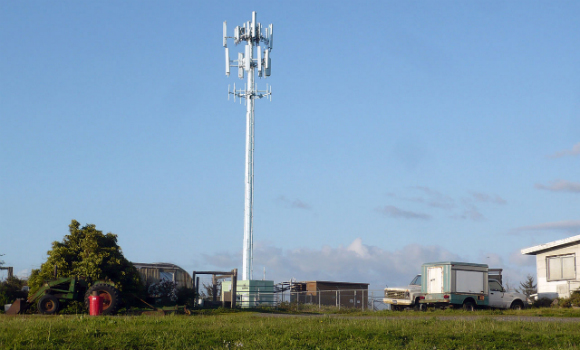
Cell tower in Humboldt County, California (Photo Credit: Ellin Beltz)
If you live in an urban or suburban area, you take for granted the fact that you have easy access to the internet, or that you have cell service in most places. That’s not the case for those living in rural areas.
Four percent or 1.4 million people live without access to broadband internet, according to the California Emerging Technology Fund (CETF), which worked with the Governor’s California Broadband Task Force to map broadband access. Most of those without access live in rural or remote areas of the state. One of the most affected areas is the San Joaquin Valley. This rural digital divide affects both households and businesses, including the area’s biggest industry – farming.
“One of the barriers is infrastructure,” explained Eduardo Gonzalez, program manager for the San Joaquin Valley “Get Connected” program run through California State University Fresno’s Office of Community and Economic Development (OCED). “The new infrastructure that is going in is not hitting the local farmers, not hitting your very rural, isolated communities, specifically for business growth and business development.”
He added, “One of the issues that I see is that there’s a big need for wireless connectivity. And so that’s what the farmers are really looking for. Because businesses can deal with broadband connection, plugged in to their system, but farmers are depending on wireless connectivity.”
Fifth-generation farmer Kenny Watkins of Linden agreed about how important broadband is to his farm. “Monitoring systems for my irrigation system are set-up with the wheel driven by GPS, that’s what keeps it straight.”
One example of a success in the region happened this year when a large grant from the California Advanced Service Fund (PDF) was awarded to a project to bring broadband internet to the Cressman area of Fresno County. Benefiting from the access will be 70 households, most of which were completely without wired internet access.
But Watkins, who is also the First Vice President of the California Farm Bureau expressed his frustration with mobile service in the San Joaquin Valley. “If I had better cellular service here, I can control it from my iPhone and see where it’s at and monitor it.”
Bringing broadband access to unserved or underserved communities, such as farmers in rural or remote areas is the goal of the San Joaquin Valley Broadband Regional Consortium, run out of the OCED offices.
“There’s a couple of things that we can do to bring wireless to the farmers, one of them is working with local internet service providers (ISPs), that can leverage their cell sites, or their connectivity to wireless to expand those areas where farmers most need it,” said Gonzalez. He added that wireless carriers are realizing the importance of serving the rural areas, noting that Verizon recently built a cell site in the remote town of Orosi, which had very weak connectivity until the installation. The company realized it was just good business.
Gonzalez said some farmers put up their own cell towers. “I’ve seen where farmers put it up on their own buildings at the highest point possible, so that they can cover a mile radius, so that their tractors can connect wirelessly.”
With agencies such as the Consortium working with wireless carriers and ISPs on infrastructure, the goal is to have broadband access to 100 percent of California’s residents. And, better broadband and wireless access means more economic prosperity for the region’s residents, famers and small businesses.
According to Watkins, wireless changed everything in the Valley and it’s hard to go without. “Before we didn’t know any better, but now that we’ve had this technology for so long, you’re used to being able to get instant updates, connections or having someone on each side of the field when you want something.”

